

This amazing flower was "discovered" during the 1700s in South America. It was then used about the turn of the century, around 1800, to create the lovely more well-known hybrid, the Hardy Amaryllis which is also known as the St. Joseph's Lily. It is a cold hardy bulb that is white with maroon striping. Enjoy rapid reproduction, trumpet shapes, and clean foliage! A must have in every garden. Scott Ogden in his book Garden Bulbs for the South says that the Hippeastrum vittatum has a "hardy constitution." This is the bulb that you will want if you want an "amaryllis" to come up every spring and survive the winter in the south.

Blooms: These bloomers are reliable every spring and bloom along side our other heirloom amaryllis friends. This April-bloomer is a great garden flower that has much variation in the amount of pink/maroon or white in the blooms of the individual bulbs. No matter the final combination, each bulb impressively produces beautiful white flowers with dark pink/maroon stripes. It displays cold hardy characteristics similar to the hardy amaryllis or Johnson's amaryllis (Hippeastrum x johnsonii). The blooms will be about 5-6 inches and create a beautiful display with several crowded together on the top of the stem. The blooms provide a lovely scent for you to enjoy. The scent is describe as lightly floral and fruity.
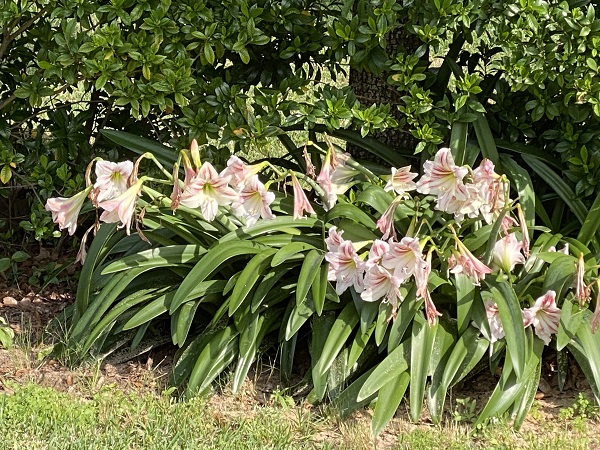
Foliage: Though purchased for the amazing striped blooms, the foliage on this amaryllis is lovely. We love a bulb whose foliage can perform and impress all on its own, especially during hot dry summers. The foliage of the Hippeastrum vittatum does just that. Each leaf is 18-24 inches long and stands tall and proud even in 100+ degree weather. This bulb is drought-tolerant, but it will perform better if you water it during a dry summer. This provides a great "hedge" for an area like around a tree. The foliage provides a dark background to showcase small summer flowers like rain lilies or blood lilies or even fall blooms like red or yellow spider lilies or schoolhouse lilies. You can also use it as a foreground plant for tall flowers that may not have great foliage. Or you can even combine these ideas and have multiple layers to your garden that will bloom at different times of the year in the same area. For the foliage alone consider planting it as a centerpiece in your garden. The blooms are an added bonus!
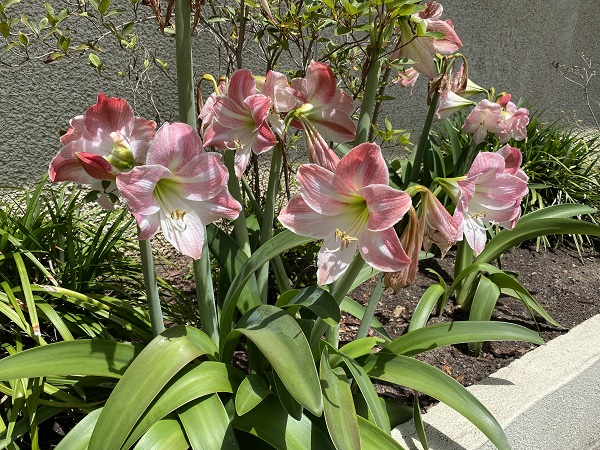
After Blooming: As with most perennial bulbs, do NOT cut down the foliage as long as it is green. The foliage is sending nutrients to the bulb for future blooms. When the foliage dies back and is completely yellow, you can cut it off for the winter. The foliage will stay green for months and may not die back if there is not a harsh winter or in warmer zones.
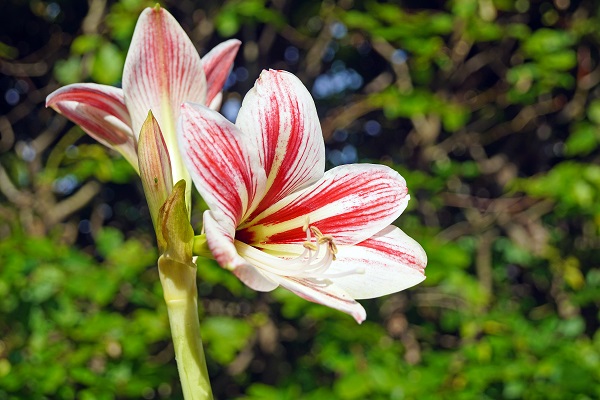
Cut flowers: These blooms are often used in floral displays and are quite costly so plant several and enjoy them in the garden and then take some indoors as well. You spend a lot of money on these blooms if you were to go buy them individually to make a flower arrangement. Instead, why not just walk out to your garden and cut a couple of stems off? These have a lovely scent to them. Many people describe it as fresh and soft because it seems to be a mixture of floral and fruity.
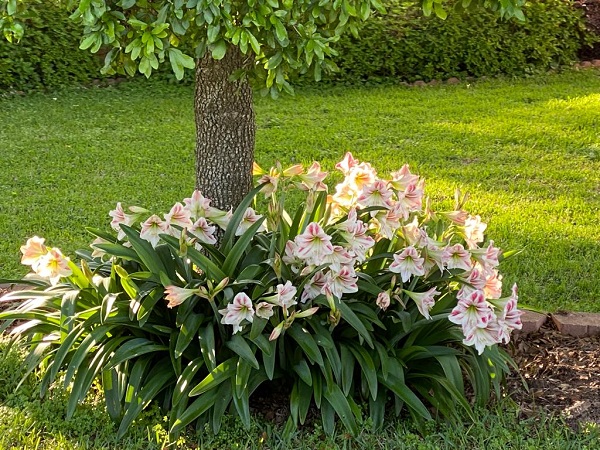
Care and Planting: Hippeastrum vittatum bulbs prefer to be planted in well-drained soil where they will receive at least 8 hours of sunlight every day. You can plant them in full sun even in zones 9 and 10. They look great as a border, around a tree, or as a centerpiece in your garden. Plant the bulbs with just the top of the stem out of the soil. If your bulb has a lot of greenery you will be able to tell where the bulb begins and just barely cover the round bulb portion. Plant these in the ground in zones 7-10. Plant each bulb about 6-8 inches apart to allow a little space for multiplication. You can plant them 4-6 inches apart if you want the area to look more natural quicker.
During the winter, consider mulching over the top especially if you are in zones 7 and 8 just as a little extra protection. Once established, these bulbs multiply quickly.
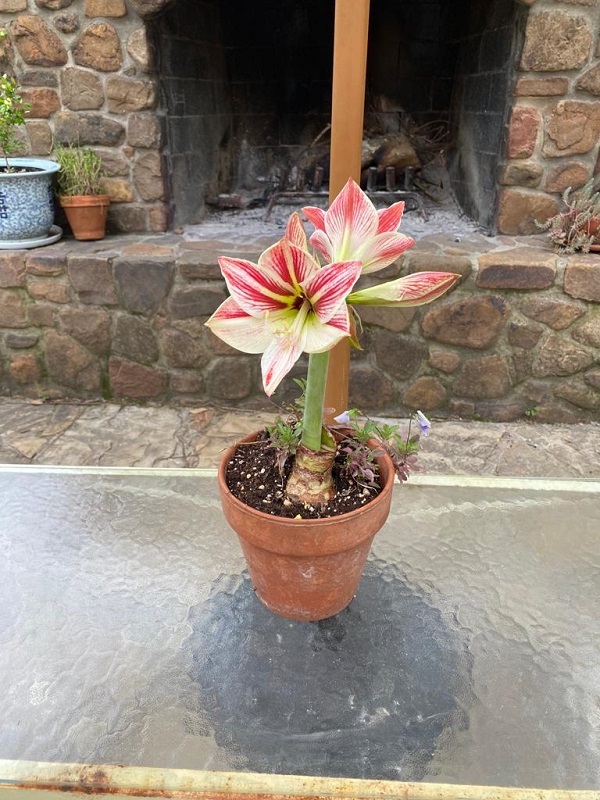
In Pots: This beauty does great being placed in pots. They are easy to grow in pots and look amazing when you plant one bulb per small pot and set them in clusters, lined up, or set in windowsills. Hippeastrum like to be a little "crowded" so only plant in a pot that allows no more than 1-2 inches around the bulb. Remember to allow the top of the bulb to stick out of the soil when you are planting.
Pots would allow someone in a colder zone to grow this spring-blooming beauty that could then be moved into a protected area during the winter. If you plant them in pots, you will need to water more frequently during the growing season, but make sure that the pot has excellent drainage. In early spring make sure to give it plenty of sunlight.
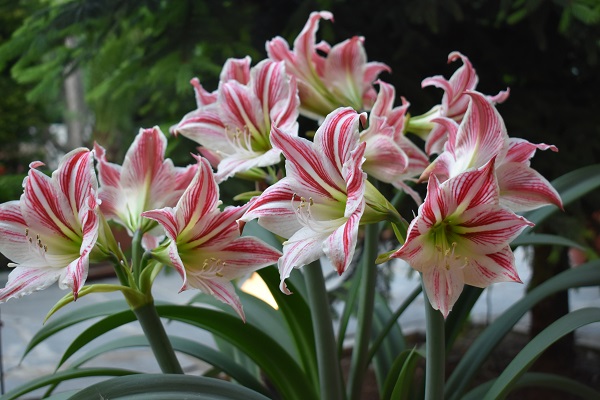
Pollinators: Bees and butterflies are really drawn to this April bloom.
Fun Facts:
Meaning: Hippeastrum means "Knight's star" and vittatum means "striped" so literally a "striped Knight's star"
This amazing flower was "discovered" during the 1700s in South America. It was then used about the turn of the century, around 1800, to create the lovely more well-known hybrid, the Hardy Amaryllis which is also known as the St. Joseph's Lily. It is a cold hardy bulb that is white with maroon striping. Enjoy rapid reproduction, trumpet shapes, and clean foliage! A must have in every garden. Scott Ogden in his book Garden Bulbs for the South says that the Hippeastrum vittatum has a "hardy constitution." This is the bulb that you will want if you want an "amaryllis" to come up every spring and survive the winter in the south.

Blooms: These bloomers are reliable every spring and bloom along side our other heirloom amaryllis friends. This April-bloomer is a great garden flower that has much variation in the amount of pink/maroon or white in the blooms of the individual bulbs. No matter the final combination, each bulb impressively produces beautiful white flowers with dark pink/maroon stripes. It displays cold hardy characteristics similar to the hardy amaryllis or Johnson's amaryllis (Hippeastrum x johnsonii). The blooms will be about 5-6 inches and create a beautiful display with several crowded together on the top of the stem. The blooms provide a lovely scent for you to enjoy. The scent is describe as lightly floral and fruity.

Foliage: Though purchased for the amazing striped blooms, the foliage on this amaryllis is lovely. We love a bulb whose foliage can perform and impress all on its own, especially during hot dry summers. The foliage of the Hippeastrum vittatum does just that. Each leaf is 18-24 inches long and stands tall and proud even in 100+ degree weather. This bulb is drought-tolerant, but it will perform better if you water it during a dry summer. This provides a great "hedge" for an area like around a tree. The foliage provides a dark background to showcase small summer flowers like rain lilies or blood lilies or even fall blooms like red or yellow spider lilies or schoolhouse lilies. You can also use it as a foreground plant for tall flowers that may not have great foliage. Or you can even combine these ideas and have multiple layers to your garden that will bloom at different times of the year in the same area. For the foliage alone consider planting it as a centerpiece in your garden. The blooms are an added bonus!

After Blooming: As with most perennial bulbs, do NOT cut down the foliage as long as it is green. The foliage is sending nutrients to the bulb for future blooms. When the foliage dies back and is completely yellow, you can cut it off for the winter. The foliage will stay green for months and may not die back if there is not a harsh winter or in warmer zones.

Cut flowers: These blooms are often used in floral displays and are quite costly so plant several and enjoy them in the garden and then take some indoors as well. You spend a lot of money on these blooms if you were to go buy them individually to make a flower arrangement. Instead, why not just walk out to your garden and cut a couple of stems off? These have a lovely scent to them. Many people describe it as fresh and soft because it seems to be a mixture of floral and fruity.

Care and Planting: Hippeastrum vittatum bulbs prefer to be planted in well-drained soil where they will receive at least 8 hours of sunlight every day. You can plant them in full sun even in zones 9 and 10. They look great as a border, around a tree, or as a centerpiece in your garden. Plant the bulbs with just the top of the stem out of the soil. If your bulb has a lot of greenery you will be able to tell where the bulb begins and just barely cover the round bulb portion. Plant these in the ground in zones 7-10. Plant each bulb about 6-8 inches apart to allow a little space for multiplication. You can plant them 4-6 inches apart if you want the area to look more natural quicker.
During the winter, consider mulching over the top especially if you are in zones 7 and 8 just as a little extra protection. Once established, these bulbs multiply quickly.

In Pots: This beauty does great being placed in pots. They are easy to grow in pots and look amazing when you plant one bulb per small pot and set them in clusters, lined up, or set in windowsills. Hippeastrum like to be a little "crowded" so only plant in a pot that allows no more than 1-2 inches around the bulb. Remember to allow the top of the bulb to stick out of the soil when you are planting.
Pots would allow someone in a colder zone to grow this spring-blooming beauty that could then be moved into a protected area during the winter. If you plant them in pots, you will need to water more frequently during the growing season, but make sure that the pot has excellent drainage. In early spring make sure to give it plenty of sunlight.

Pollinators: Bees and butterflies are really drawn to this April bloom.
Fun Facts:
Meaning: Hippeastrum means "Knight's star" and vittatum means "striped" so literally a "striped Knight's star"